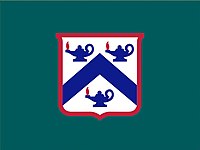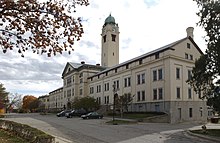United States Army Combined Arms Center
| United States Army Combined Arms Center | |
|---|---|
 U.S. Army Combined Arms Center Flag | |
| Active | 1 July 1973–present |
| Country | |
| Branch | |
| Role | Provides leadership and supervision for leader development and professional military and civilian education. |
| Size | 2,000+ |
| Part of | 16 major schools and centers. |
| Garrison/HQ | Fort Leavenworth, Kansas, U.S. |
| Nickname(s) | Intellectual Center of the Army |
| Motto(s) | Ad Bellum Pace Parati ("Prepared in peace for war") |
| Colors | Argent, a chevron Azure between three lamps of the like flamed Proper |
| Commanders | |
| Current commander | LTG Michael Lundy |
| Insignia | |
| U.S. Army Combined Arms Center Shield |  |
The U.S. Army Combined Arms Center (USACAC) is located at Fort Leavenworth and provides leadership and supervision for leader development and professional military and civilian education; institutional and collective training; functional training; training support; battle command; doctrine; lessons learned and specified areas the Commanding General, United States Army Training and Doctrine Command (TRADOC) designates in order to serve as a catalyst for change and to support developing relevant and ready expeditionary land formations with campaign qualities in support of the joint force commander.
Components
Components (all based in Fort Leavenworth) are:[1]
- Battle Command Knowledge System
- U.S. Army Information Operations Proponent
- Combat Studies Institute
- Current Force Integration Directorate
- U.S. Army Command and General Staff College (the Army's graduate school and the center's most famous institution)
- Combined Arms Center for Training (which includes the Mission Command Training Program and the National Simulations Center)
- TRADOC Program Integration Office-Battle Command
- Center for Army Lessons Learned
- Combined Arms Doctrine Directorate
- Center for Army Leadership
- Military Review
- Mission Command Center of Excellence
Components (based in Fort Rucker) are:
Overview
Fort Leavenworth, Kansas is the oldest continuously operating Regular Army installation west of the Mississippi River. This historic post, noted for its campus setting, open green spaces and hometown character, is the home of the US Army’s Combined Arms Center (CAC). CAC, as a major subordinate headquarters of the US Army Training and Doctrine Command, has often been referred to as the “Intellectual Center of the Army”. It is, in many regards, “home base” for the majority of field grade officers across the Army.
Since 1882, CAC and its predecessor organizations have been engaged in the primary mission of preparing the Army and its leaders for war. At present, this mission is divided between preparing the Army for the Global War on Terrorism and transforming it to meet future threats.
In order to accomplish these critical missions, CAC provides Army-wide leadership and supervision for leader development and professional military and civilian education; institutional and collective training; functional training; training support; battle command; doctrine; lessons learned; and other specified areas that the TRADOC Commander designates. All of these are focused toward making CAC a catalyst for change and to support the development of a relevant and ready ground force to support joint, interagency and multinational operations anywhere in the world.[2]
Organizational structure

The Combined Arms Center is organized along four basic levels:
The commander exercises overall responsibility over assigned personnel and subordinate organizations to ensure that assigned missions are accomplished in the most efficient and effective manner possible. The Command Sergeant Major, by tradition, is responsible for the conduct and development of enlisted soldiers and non-commissioned officers across the command.
The CAC Chief of Staff manages and oversees the activities of a coordinating staff and a special staff. The coordinating staff is focused on policy and procedure development for the command; the special staff provides command-wide advice in specialized or technical areas.
Major subordinate organizations carry out the majority of the functions assigned to the CAC commander. In general, each is resourced for and focused on a core function and one or more specified functions.
Schools, centers and specialized activities are spread across the country and are responsible for executing a portion of the CAC mission. In general, each of these organizations is responsible for the training of specific branch skills (such as "Infantry") and serving as the Army's functional expert in that area. In this regard, CAC is an integrator of specialized skills, on one hand, and an executor of common skills, on the other.
Military Review
Since 1922, the center has published the bimonthly journal Military Review.[3][4]
Commanders
Since 1976 commandant of the college has been a Lieutenant General (three stars). David Petraeus was a commandant immediately before going to command the Multinational Force - Iraq.
Lieutenant General James C. Riley from Jul 01 to Jun 03
Lieutenant General William S. Wallace from Jul 03 to Oct 05
Lieutenant General David H. Petraeus from Oct 05 to Feb 07
Lieutenant General William B. Caldwell IV from Jun 07 to Nov 09
Lieutenant General Robert L. Caslen, Jr. from Feb 10 to Sep 11
Lieutenant General David G. Perkins from Nov 11 to Feb 14
Lieutenant General Robert B. Brown from Feb 14 to Apr 16
Lieutenant General Michael Lundy from Apr 16 to present
See also
- Fort Leavenworth, Kansas
- U.S. Army Training and Doctrine Command
- U.S. Army Command and General Staff College
- U.S. Army Warrant Officer Career College
- Buffalo Soldier
- Center for the Army Profession and Ethic (CAPE)
References
- ^ Fort Leavenworth Tenants army.mil Retrieved 11 October 2009
- ^ "Combined Arms Center Overview". Usacac.army.mil. 27 January 2010. Retrieved 26 May 2011.
- ^ ISSN 0026-4148; OCLC 2558412
- ^ United States Army Combined Arms Center: MR Spotlight
External links
- Combined Arms Center Official Website
- Combined Arms Center and Fort Leavenworth Official Website
- Example for a study: Medical support of the deliberate river crossing (1992) (pdf, 92 pages)

